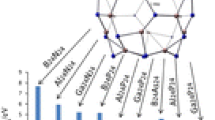Abstract
The interactions between the embedded atom X (X = Li, Na, K, Rb, Cs; F, Cl, Br, I) andC60 cage in the endohedral-form complexes (X@C60) are calculated and discussed according to molecular mechanics from the point of view of the bonding and non-bonding. It is found from the computational results that for atoms with radii larger than Li’s, their locations with the minimum interaction in (X@C60) are at the cage center, while atom Li has an off-center location with the minimum interaction deviation of ~0.05 nm, and the cage-environment in C60 can be regarded as syhero-symmetry in the region with radiusr of ~0.2 nm. It is shown that the interaction between X and C60 cage is of non-bonding characteristic, and this non-bonding interaction is not purely electrostatic. The repulsion and dispersion in non-bonding interactions should not be neglected, which make important contribution to the location with minimum interaction of X, at center or off center. Some rules about the variations of interactions with atomic radii have been obtained.
Similar content being viewed by others
References
Bethune, D. S., Johnson, R. D., Salem, J. R.et al. Atoms in carbon cages: the structure and properties of endohedral fullerenes,Nature, 1993, 336: 123.
Cioslowski, J., Endohedral chemistry: Electronic structures of molecules trapped inside the C60 cage.J. Am. Chem. Soc., 1991, 113: 4139.
Cioslowski, J., Nanayakkara, A., Endohedral fullerenes: A new class of ferroelectric materials.Phys. Rev. Lett., 1992, 69:2871.
Liu, J., Iwata, S., Gu, B., Structural properties of the endohedral complex Na+ @C60,J. Phys: Condens. Matter, 1994. 6: L253.
Zhu, C. B., Yan, J. M., Interaction between the alkali atoms and the C60 cage in the endohedral complexes (Alkali@C60),Chinese Science Bulletin, 1995, 40: 1789.
Yan, J. M., Zhu, C. B., Interactioin and variation of C60 in endohedral complexes (X@C60) (X = alkali or halogen).J. Mol. Struct. (Theochem.), 1995, 358: 167,
Zhu, C. B., Yan, J. M., Investigation on the interaction of the halogen atoms with the C60 cage in the halogen-enclosed complexes (Halogen@C60),Chinese Chem. Lett. (in Chinese), 1995, 6: 867.
Dunlap, B. I., Ballester, J. L., Schmidt, P. P., Interaction between C60 and endohedral alkali atoms,J. Phys. Chem., 1992, 96:9781.
Wang, L., Alford, J. M., Chai, Y.et al., The electronic structure of Ca@C60,Chem. Phys. Lett., 1993, 207: 354.
Guo, T., Greory, K. O., Scuseria, G. E., Electronic structure of Cs@C60: Anab initio theoretical study,J. Phys. Chem., 1994, 98: 7745.
Yannoni, C. S., Bemier, P. P., Bethune, D. S.et al., NMR determination of the bond lengths in C60.I. Am. Chem. Soc., 1991, 113: 3190.
Zhang, D. R., Wu, J. A., Yan, J. M., Electronic structures of the alkali-containing buckminsterfullerenes (A@C60) (A= Li, Na,K, Rb, Cs) and the halogen-containing buckminsterfullerenes (H@C60) (H = F, Cl, Br. I),J. Mol. Struc. (Theochem.), 1993. 2: 87.
Williams, D. E., Yan, J. M., Point-charge models for molecules derived from least-squares fitting of the electronic potential,Adv. Atomic and Molecular Phys., 1987, 23: 87.
Anderson, A. B., Grimes, R. W., Hong, S. Y., Toward a better understanding of the atom superposition and electron delocalization molecular orbital theory and a systematic test: Diatomic oxides of the first transition-metal series,J. Phys. Chem., 1987, 91: 4245.
Busing, W. R..WMIN, A Computer Program to Model Molecules and Crystals in Terms of Potential Energy Functions, Oak Ridge: Oak Ridge National Lab., 1981.
Xu, G. X. Wang, X. Y.,Material Structure (in Chinese), 2nd ed., Beijing: Higher Education Press, 1987.
Author information
Authors and Affiliations
Additional information
Project supportt:d by the National Natural Science Foundation of China.
Rights and permissions
About this article
Cite this article
Zhu, C., Xu, Z. & Yan, J. Molecular mechanics on bonding and non-bonding interactions in (atom@C60). Sc. China Ser. B-Chem. 40, 503–511 (1997). https://doi.org/10.1007/BF02875419
Received:
Issue Date:
DOI: https://doi.org/10.1007/BF02875419




